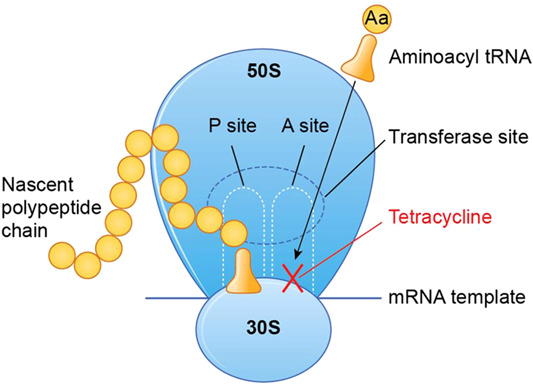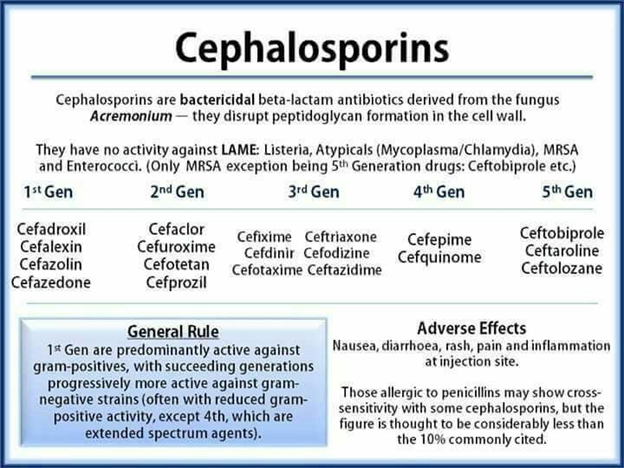A nursing student asks the nursing instructor about the mechanism of the bacteriostatic action of tetracycline. Which explanation is correct?
"Tetracycline inhibits protein synthesis."
"Tetracycline blocks RNA synthesis."
"Tetracycline degrades the bacterial cell wall."
"Tetracycline binds to magnesium ions."
The Correct Answer is A
A. "Tetracycline inhibits protein synthesis."
Explanation: Tetracycline antibiotics interfere with bacterial protein synthesis by binding to the bacterial ribosomes. This binding prevents the attachment of transfer RNA (tRNA) to the messenger RNA (mRNA) complex, effectively inhibiting the production of proteins that are crucial for bacterial growth and replication.
B. "Tetracycline blocks RNA synthesis."
Explanation: This statement is incorrect. Tetracycline primarily affects protein synthesis, not RNA synthesis. It doesn't block the creation of RNA molecules in bacteria.
C. "Tetracycline degrades the bacterial cell wall."
Explanation: This statement is incorrect. Tetracycline antibiotics do not target bacterial cell walls. Agents like penicillins and cephalosporins are examples of antibiotics that disrupt bacterial cell walls.
D. "Tetracycline binds to magnesium ions."
Explanation: This statement is incorrect. Tetracycline does bind to certain metal ions, but it's not primarily through magnesium ions. The binding to bacterial ribosomes is a key mechanism of action for tetracyclines.

Nursing Test Bank
Naxlex Comprehensive Predictor Exams
Related Questions
Correct Answer is C
Explanation
A. "Cephalosporins are assigned to generations based on their relative costs to administer."
This statement is incorrect. The classification of cephalosporins into generations is based on their antimicrobial spectrum and activity against specific bacteria, not their cost.
B. "Later generations of cephalosporins have lower resistance to destruction by beta-lactamases."
This statement is not accurate. In fact, later generations of cephalosporins have increased resistance to destruction by beta-lactamases, which are enzymes produced by bacteria that can break down certain antibiotics.
C. "Cephalosporins have increased activity against gram-negative bacteria with each new generation."
This statement is correct. Cephalosporins are grouped into generations (first to fifth) based on their antibacterial spectrum. As the generations progress, there is an increase in activity against gram-negative bacteria, among other improvements in their spectrum.
D. "First-generation cephalosporins have better penetration of the cerebrospinal fluid."
This statement is generally true. First-generation cephalosporins have better penetration into the cerebrospinal fluid, making them useful for treating certain central nervous system infections.
Correct Answer is A
Explanation
A. Ceftaroline (Teflaro) is a fifth-generation cephalosporin antibiotic that is effective against MRSA (Methicillin-Resistant Staphylococcus Aureus). It's the first cephalosporin in its class with this capability, making it a valuable choice in treating MRSA infections.
B. Cefepime (Maxipime) is a fourth-generation cephalosporin that does not have specific activity against MRSA.
C. Ceftriaxone (Rocephin) is a third-generation cephalosporin, effective against a wide range of bacteria, but not specifically targeted at MRSA.
D. Cephalexin (Keflex) is a first-generation cephalosporin, primarily effective against Gram-positive bacteria, but not effective against MRSA.

Whether you are a student looking to ace your exams or a practicing nurse seeking to enhance your expertise , our nursing education contents will empower you with the confidence and competence to make a difference in the lives of patients and become a respected leader in the healthcare field.
Visit Naxlex, invest in your future and unlock endless possibilities with our unparalleled nursing education contents today
Report Wrong Answer on the Current Question
Do you disagree with the answer? If yes, what is your expected answer? Explain.
Kindly be descriptive with the issue you are facing.
